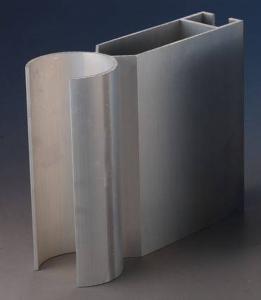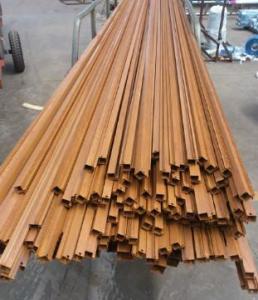Aluminum Extrusion Profiles for 100mm Double Glass/Wood Office Partitions
- Loading Port:
- Shanghai
- Payment Terms:
- TT OR LC
- Min Order Qty:
- 5 m.t.
- Supply Capability:
- 5000 m.t./month
OKorder Service Pledge
OKorder Financial Service
You Might Also Like
Specification
Structure of Aluminum Profiles 100mm Double Glass/Wood Office Partitions Description:
We have more than 10 years experiences on manufacturing kinds of aluminum profiles, such as Aluminum Window & Door profiles, Aluminum tile trim profiles, Aluminum profiles for LED light, Round/Square General profiles, Aluminum heat sink, Aluminum heating insulation profiles, Curtain wall Aluminum profiles, and others Industry profiles.
Our products have exported to all over the world, and we also have a large of market share in Algeria, Angola, Philippine, Guinea, Ghana, South Africa, Nepal, Nigeria, Tanzania, Iraq etc.
Main Features of the Aluminum Profiles 100mm Double Glass/Wood Office Partitions:
1, Strong R&G: help customers finalize the design, strong tool design ability, excellent, pressing and surface treatment technology;
2, Strong quality management: ISO&SGS SYSTEM;
3, 24 hours on-line communication, professional, patient, flexible;
4, High capacity of manufacturing and wide range of products;
5, We can provide secondary manufacturing.
6, High corrosion resistance, high weather resistance and good wear resistance.
7, Alternative surface treatment: Colorful ANODIZE, POWDER COATING, ELECTROPHORESIS & WOODEN GRAIN. Plentiful colors upon your needs.
8, Excellent material for smooth and subtle edges, elegant appearance.
9, Strong coated adhesion which is suitable for construction and industrial material.
Images of the Aluminum Profiles 100mm Double Glass/Wood Office Partitions:



Aluminum Profiles 100mm Double Glass/Wood Office Partitions Specification:
Material | Alloy Aluminum 6063,6061,6005 or customer nominated |
Temper | T3, T4, T5, T6 |
Surface | Anodize, electrophoresis, powder coating, PVDF coating, wood grain painting, matted, etc. |
Colour | Any colour based on Standard Germany RAL Mark |
Length | Coating 6.5 meters, Anodizing 6.5 meters, Mill finish 5 meters |
Press Machine | 500-4000 tons all together 64 press lines. |
Fabrication | 1. Windows and doors; 2. Drilling; 3. Bending; 4. Cutting; 5. etc. |
Certificate | ISO 9001 |
Moulding | 1. Using our moulds, no fee; |
2. Using customer drawing, opening mould, usually about 10~50 tons then the moulding can be refunded. | |
3. Mould cost is negotiable base on the order quantity | |
Capability | Annual output 100,000 tons |
FAQ:
1.Q: What about leadtime ?
A: Normally the leadtime is 60days after we receive the deposit and confirm the details. All the press machines we use is the best quality in China Yangli brand. The press machine leadtime from Yangli is 50days, the best leadtime we can give is 60days.
2.Q: What's the lead time for moulds?
A: Normally the mould leadtime is 45 days after we confirm all the details with customer. Our professional mechanical enginners from Austria will design the mould according to the samples from customer, or by the specifications offered by customers.
3.Q:What kinds of mould you can make? and what is your strong point for the moulds?
A: we can make wrinkle wall mould and smooth wall mould both. For wrinkle wall mould we can make, 79" pan, fish pan, bbq pan. For smooth wall mould we can make muffin cup, and cake cup, tar cup,etc. We can also make 2 or 3 portion conatiner moulds as long as you offer us sample or specifications. Our strong points are all our moulds are WEDMLS cut, which makes the mould more accurate and precise. Important materials likestainless steel parts we make in Austria. We also recut after heat treatment, which most of makers do not take this process.
- Q: Are aluminum profiles suitable for use in the defense industry?
- The defense industry finds aluminum profiles to be a fitting option. Aluminum, a lightweight material, possesses an excellent strength-to-weight ratio, making it the preferred choice for various defense applications. Military vehicles, aircraft, and naval vessels can be constructed using aluminum profiles, which significantly contribute to weight reduction, thus enhancing performance and fuel efficiency. Moreover, aluminum profiles exhibit remarkable resistance to corrosion, a crucial characteristic for defense equipment exposed to harsh conditions like saltwater or extreme weather. They also display efficient thermal conductivity, enabling effective heat dissipation in electronic components and systems. In addition to these advantages, aluminum profiles offer exceptional design versatility and can be easily machined, welded, and formed into intricate shapes. This adaptability allows for customization, meeting specific defense requirements. Furthermore, aluminum profiles contribute to cost-effectiveness as they are readily available, recyclable, and offer long-term durability. To conclude, due to their lightweight nature, resistance to corrosion, thermal conductivity, versatility, and cost-effectiveness, aluminum profiles prove to be a suitable choice for the defense industry. These properties make them ideal for a wide range of applications, ensuring the durability and performance of defense equipment.
- Q: What are the strategies to reduce the environmental footprint when utilizing aluminum profiles in construction projects?
- <p>To minimize the environmental impact of using aluminum profiles in construction, consider the following strategies: Use recycled aluminum whenever possible, as it requires significantly less energy to produce than new aluminum. Opt for energy-efficient manufacturing processes and choose suppliers with strong environmental credentials. Design for disassembly and recycling to facilitate the reuse of aluminum profiles at the end of their life. Implement sustainable construction practices that reduce waste and emissions. Finally, educate stakeholders about the importance of sustainable materials and encourage the adoption of eco-friendly practices throughout the construction process.</p>
- Q: Are aluminum profiles suitable for fencing and gates?
- Yes, aluminum profiles are suitable for fencing and gates. Aluminum is a popular choice for these applications due to its durability, strength, and low maintenance requirements. It is resistant to rust, corrosion, and weathering, making it an excellent choice for outdoor use. Additionally, aluminum profiles offer versatility in terms of design, allowing for various styles and customization options. They are lightweight yet sturdy, making them easy to install and handle. Furthermore, aluminum is a sustainable and environmentally friendly material, as it is 100% recyclable. Overall, aluminum profiles provide a practical and aesthetically pleasing solution for fencing and gates.
- Q: How do aluminum profiles perform in vibration isolation applications?
- Aluminum profiles are highly effective in vibration isolation applications due to their unique properties and characteristics. The use of aluminum profiles in such applications helps to minimize and dampen vibrations, creating a stable and isolated environment. One of the primary reasons for the effectiveness of aluminum profiles in vibration isolation is their high strength-to-weight ratio. Aluminum is a lightweight material, which allows for the construction of structures that can effectively absorb and dissipate vibrations. This lightweight nature ensures that the profiles do not add excessive weight to the system, as added weight can amplify vibrations rather than dampen them. Additionally, aluminum profiles have excellent damping capabilities. Damping refers to the ability of a material to absorb and dissipate energy from vibrations. Aluminum possesses inherent damping properties, which significantly contribute to reducing vibration levels. This ensures that the profiles effectively isolate vibrations and prevent their transmission to other components or structures. Furthermore, aluminum profiles can be easily customized and designed to meet specific vibration isolation requirements. They can be engineered to have specific geometries and configurations, allowing for the creation of structures that effectively attenuate vibrations. This flexibility in design enables the optimization of the profiles for different applications and environments, ensuring maximum effectiveness in vibration isolation. Moreover, aluminum profiles offer good corrosion resistance, which is crucial in vibration isolation applications that may be exposed to harsh operating conditions. This corrosion resistance ensures the longevity and reliability of the profiles, maintaining their performance over extended periods. In summary, aluminum profiles are highly suitable for vibration isolation applications due to their lightweight nature, excellent damping capabilities, customization options, and corrosion resistance. Through their effective vibration absorption and dissipation properties, aluminum profiles help to create stable and isolated environments, minimizing the impact of vibrations on surrounding components or structures.
- Q: Do aluminum profiles require any special maintenance?
- There is no need for any special maintenance for aluminum profiles. They are durable and require minimal maintenance, as they are resistant to corrosion, rust, and weathering. Unlike wood or steel, aluminum profiles do not require regular painting, staining, or treatment to maintain their appearance or functionality. Moreover, aluminum is lightweight, making it easy to handle and install. However, it is essential to keep the aluminum profiles clean by regularly using a mild detergent and water solution to remove dirt or debris. This will help to maintain the profiles' aesthetic appeal and ensure their longevity. In summary, aluminum profiles are a convenient and hassle-free choice for various applications, as they do not demand any special maintenance.
- Q: Are aluminum profiles suitable for use in architectural lighting fixtures?
- <p>Yes, aluminum profiles are commonly used for architectural lighting fixtures due to their durability, lightweight nature, and excellent heat dissipation properties. They offer design flexibility and can be easily shaped and machined to fit various lighting designs. Additionally, aluminum's resistance to corrosion makes it ideal for both indoor and outdoor lighting applications.</p>
- Q: This question asks about the various thicknesses and grades of aluminum profiles that are specifically used for roofing purposes.
- <p>Aluminum profiles for roofing come in different thicknesses and grades, which determine their strength and suitability for various applications. Common thicknesses range from 0.5mm to 1.5mm, with 0.5mm and 0.6mm being the most common for residential roofing. For commercial and industrial applications, thicknesses of 0.8mm to 1.5mm are often used due to their increased load-bearing capacity. Grades of aluminum profiles are typically classified based on their alloy composition, with 1100, 3003, 5005, and 6061 being the most common. Each grade has different properties, such as corrosion resistance, formability, and strength, which make them suitable for specific roofing applications. For instance, 3003-grade aluminum is widely used for roofing due to its good formability and moderate strength. The choice of thickness and grade depends on the specific requirements of the roofing project, such as the expected load, environmental conditions, and aesthetic preferences.</p>
- Q: What is the limitation of aluminum bending
- Because the aging hardness will increase, and then take the bend, one is not easy to bend, and the other out of the bend, the effect is not good. So generally speaking like hanging rail is the first bend reaging.
- Q: This question seeks advice on making the aluminum profile production process eco-friendly.
- <p>To ensure an environmentally friendly production process for aluminum profiles, consider the following: Use recycled aluminum whenever possible to reduce the energy needed for production. Implement energy-efficient technologies and machinery in the production line. Minimize waste by optimizing production processes and recycling any aluminum scraps generated. Employ water-saving measures and treat any wastewater before discharge. Reduce emissions by using low-emission fuels and investing in pollution control equipment. Regularly monitor and assess the environmental impact of your operations and strive for continuous improvement.</p>
- Q: Can aluminum profiles be used in noise insulation applications?
- Yes, aluminum profiles can be used in noise insulation applications. Aluminum profiles have good structural integrity and can be used to create soundproof barriers or enclosures. They can also be combined with other sound-absorbing materials to enhance noise insulation properties.
Send your message to us
Aluminum Extrusion Profiles for 100mm Double Glass/Wood Office Partitions
- Loading Port:
- Shanghai
- Payment Terms:
- TT OR LC
- Min Order Qty:
- 5 m.t.
- Supply Capability:
- 5000 m.t./month
OKorder Service Pledge
OKorder Financial Service
Similar products
Hot products
Hot Searches
Related keywords




























